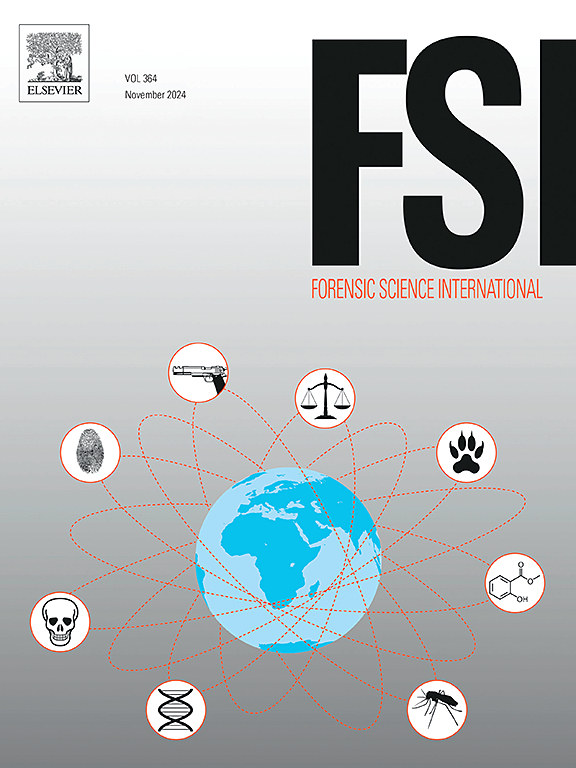Evaluating the capabilities of DART-MS compared to FTIR spectroscopy and SEM-EDS for the analysis of architectural paint mixtures
IF 2.2
3区 医学
Q1 MEDICINE, LEGAL
引用次数: 0
Abstract
Architectural paint is a type of transferred trace material typically encountered by forensic laboratories, mostly in cases of forced entry. Forensic analysis of architectural paint generally consists of bright field microscopy followed by Fourier transform infrared (FTIR) spectroscopy. Further characterization can be achieved using additional techniques such as scanning electron microscopy-energy dispersive X-ray spectroscopy (SEM-EDS), Raman spectroscopy, and pyrolysis-gas chromatography-mass spectrometry (Py-GC-MS). This study aimed to evaluate the effectiveness of DART-MS compared to FTIR spectroscopy and SEM-EDS for the analysis of architectural paint analysis, as well as investigate how DART-MS could be incorporated into a paint analysis workflow. A total of 45 architectural mixed paint samples were obtained by preparing combinations of five base color paints as binary mixtures in known proportions. DART-MS detected multiple organic compounds, including tributyl citrate (TBC), polyethylene glycol (PEG), dioctyl maleate (DOM), and tert-butyldiethanolamine (TBDEA) which are common plasticizers, additives, and solvents in architectural paints. DART-MS also showed the ability to identify the black paint in mixed paints above 10 % at both 350 °C and 500 °C, unlike FTIR and SEM-EDS. Meanwhile, FTIR spectroscopy identified several organic and inorganic compounds in each of the base color paints, including binders, pigments, and extenders, and was generally able to determine which base color paints were present in a mixture. In addition to supporting the identification of the inorganic compounds detected using FTIR, SEM-EDS also demonstrated greater sensitivity for small concentrations of inorganic compounds in the mixed paints. Overall, the compounds detected through DART-MS analysis were not found with either FTIR or SEM-EDS, highlighting the complementary nature of these techniques. Furthermore, DART-MS demonstrated the capability to identify and monitor ions specific to the black base paint within mixed paint samples, supporting the adoption of a combined approach for enhanced architectural paint discrimination.
评估DART-MS与FTIR光谱和SEM-EDS分析建筑涂料混合物的能力
建筑涂料是一种转移的痕迹材料,通常在法医实验室遇到,主要是在强行进入的情况下。建筑涂料的法医分析通常由明场显微镜和傅里叶变换红外光谱组成。进一步的表征可以使用额外的技术,如扫描电子显微镜-能量色散x射线光谱(SEM-EDS),拉曼光谱和热解-气相色谱-质谱(Py-GC-MS)。本研究旨在评估DART-MS与FTIR光谱和SEM-EDS相比在建筑涂料分析中的有效性,并研究如何将DART-MS纳入涂料分析工作流程。通过将五种基色涂料按已知比例组合成二元混合物,共获得45种建筑混合涂料样品。DART-MS检测到多种有机化合物,包括柠檬酸三丁酯(TBC)、聚乙二醇(PEG)、马来酸二辛酯(DOM)和叔丁基二乙醇胺(TBDEA),它们是建筑涂料中常见的增塑剂、添加剂和溶剂。与FTIR和SEM-EDS不同,DART-MS在350°C和500°C下都能识别出混合涂料中10% %以上的黑色涂料。同时,FTIR光谱在每种基色涂料中发现了几种有机和无机化合物,包括粘合剂、颜料和填充剂,并且通常能够确定混合物中存在哪种基色涂料。除了支持FTIR检测的无机化合物的鉴定外,SEM-EDS对混合涂料中小浓度的无机化合物也显示出更高的灵敏度。总的来说,通过DART-MS分析检测到的化合物在FTIR或SEM-EDS中都没有发现,这突出了这些技术的互补性。此外,DART-MS还展示了在混合涂料样品中识别和监测黑色底漆特定离子的能力,支持采用综合方法来增强建筑涂料的辨别能力。
本文章由计算机程序翻译,如有差异,请以英文原文为准。
求助全文
约1分钟内获得全文
求助全文
来源期刊

Forensic science international
医学-医学:法
CiteScore
5.00
自引率
9.10%
发文量
285
审稿时长
49 days
期刊介绍:
Forensic Science International is the flagship journal in the prestigious Forensic Science International family, publishing the most innovative, cutting-edge, and influential contributions across the forensic sciences. Fields include: forensic pathology and histochemistry, chemistry, biochemistry and toxicology, biology, serology, odontology, psychiatry, anthropology, digital forensics, the physical sciences, firearms, and document examination, as well as investigations of value to public health in its broadest sense, and the important marginal area where science and medicine interact with the law.
The journal publishes:
Case Reports
Commentaries
Letters to the Editor
Original Research Papers (Regular Papers)
Rapid Communications
Review Articles
Technical Notes.
 求助内容:
求助内容: 应助结果提醒方式:
应助结果提醒方式:


